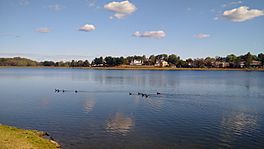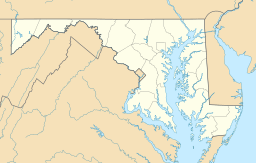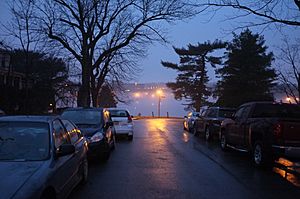Lake Montebello facts for kids
Quick facts for kids Lake Montebello |
|
|---|---|
 |
|
| Location | Baltimore City, Maryland, United States |
| Coordinates | 39°19′55″N 76°35′02″W / 39.332°N 76.584°W |
| Type | Reservoir |
| Built | 1881 |
| Settlements | Baltimore |
Lake Montebello is a large reservoir located in Northeast Baltimore City, Maryland. It was built in 1881 to help supply drinking water to the city. The lake can hold about 410 million gallons of water.
Today, Lake Montebello helps clean the city's water. It acts as a settling basin for water before it goes to the nearby filtration plants. A 1.3-mile path goes around the lake. This path is a popular spot for walking and biking for people in the area.
Contents
History of Lake Montebello
Building Baltimore's Water Supply
In 1854, people in Baltimore were looking for new sources of drinking water. The city was growing fast before the American Civil War. They thought the nearby Herring Run stream could be a good source.
Work on Lake Montebello began in 1875. The lake was dug out and finished by 1881. On September 29, 1881, the lake was completely full. At the same time, a tunnel was built to connect Lake Montebello to another reservoir, Loch Raven Reservoir.
Cleaning the Water
About 30 years later, in 1910, a big change happened. The city started adding chlorine to the water supply. This made the water much safer to drink.
After that, the first water filtration plant was built at Lake Montebello. Montebello Filtration Plant 1 opened in 1915. It was a huge project for the city. This plant helped make Baltimore's drinking water healthy. It also set a new standard for water safety across the country.
An important engineer named Abel Wolman (1892-1989) worked for Baltimore City. He became famous for his work on safe public water systems. He helped make sure people had clean water to drink.
Growing City, Growing Needs
From 1918 to 1919, Baltimore City grew much larger. It added land from nearby Baltimore County and Anne Arundel County. This meant more people needed water.
Because the city was growing, a second filtration plant was built. Montebello Plant 2 started working in 1928. Other big projects also happened to bring more water to the city. These included new tunnels and the Prettyboy Dam (1933).
After World War II, the Baltimore area continued to grow. More people moved to the suburbs around the city. This put even more demand on the water supply. Different public works departments now work together to manage the water for the whole region.
Lake Montebello Today
The original red brick buildings from 1915 are still used today. They house the indoor filter tanks. A spokesperson for public works said these plants will likely be used into the 2020s.
Officials hope to open a new water plant in Fullerton, a suburb in Baltimore County. When that new plant opens, the older Montebello plants might be updated or retired.
Local community groups work to keep the area around Lake Montebello beautiful. They help maintain the natural beauty and the paths around the lake.



